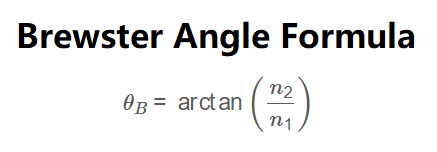 Home
Home
 Back
Back

Definition: This calculator computes the Brewster's angle (\( \theta_B \)), the angle of incidence at which light with a particular polarization is perfectly transmitted through a surface with no reflection.
Purpose: It is used in optics to determine the angle at which light becomes linearly polarized upon reflection, which is useful in designing polarizing filters and understanding light behavior at interfaces.
The calculator uses the formula for Brewster's angle:
Formula: \[ \theta_B = \arctan\left(\frac{n_2}{n_1}\right) \] Where:
Unit Conversions:
Steps:
Calculating Brewster's angle is crucial for:
Examples:
Q: What is Brewster's angle?
A: Brewster's angle is the angle of incidence at which light with a particular polarization (p-polarized) is perfectly transmitted through a surface with no reflection, resulting in the reflected light being completely s-polarized.
Q: Why is the sum of the angle of reflection and refraction 90° at Brewster's angle?
A: At Brewster's angle, the reflected and refracted rays are perpendicular to each other, which leads to the condition \( \theta_B + \theta_r = 90^\circ \). This is derived from Snell's Law and the polarization condition.
Q: How is Brewster's angle used in real life?
A: It is used in polarizing filters for photography and sunglasses to reduce glare, and in laser optics to minimize reflection losses.